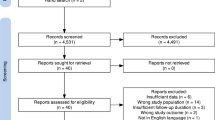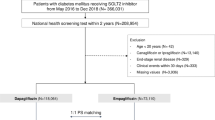Abstract
Background and Objective
The results of large placebo-controlled clinical trials to evaluate cardiovascular risks associated with drugs for type 2 diabetes mellitus indicated different cardiovascular effects among these drugs, but the detailed design of each trial was not completely the same. The aim of this study was to perform time-matched evaluation of cardiovascular risks of drugs for type 2 diabetes.
Methods
We used the difference in restricted mean survival time (RMST) as a measure of cardiovascular risks. Regarding drugs for type 2 diabetes used currently, this study included all 10 clinical trials in patients with type 2 diabetes at high cardiovascular risk the results of which have been published as of 30 November 2018. Since the shortest study follow-up time was about 672 days in SUSTAIN-6, we chose 672 days as a common time point to estimate the RMSTs regarding each safety event.
Results
The differences of RMSTs (drugs for type 2 diabetes minus placebo: point estimate and 95% confidence interval) for major adverse cardiovascular events (MACE) were 8 days (1, 15) for semaglutide, 5 days (1, 9) for liraglutide, and 7 days (2, 13) for empagliflozin. Those for death from cardiovascular causes were 5 days (2, 8) for empagliflozin and 2 days (1, 4) for canagliflozin. Those for death from any cause were 4 days (1, 8) for empagliflozin.
Conclusions
Through the evaluation up to 672 days, semaglutide, liraglutide, and empagliflozin decreased the risk of MACE. Concerning the risk of each cardiovascular event, risk reduction was seen with empagliflozin and canagliflozin.
Similar content being viewed by others
References
US Department of Health and Human Services, Food and Drug Administration; Center for Drug Evaluation and Research. Guidance for industry: diabetes mellitus—evaluating cardiovascular risk in new antidiabetic therapies to treat type 2 diabetes. https://www.fda.gov/downloads/Drugs/GuidanceComplianceRegulatoryInformation/Guidances/UCM071627.pdf. Accessed 13 Mar 2019.
Nissen SE, Wolski K. Effect of rosiglitazone on the risk of myocardial infarction and death from cardiovascular causes. N Engl J Med. 2007;356:2457–71.
White WB, Cannon CP, Heller SR, Nissen SE, Bergenstal RM, Bakris GL, et al. Alogliptin after acute coronary syndrome in patients with type 2 diabetes. N Engl J Med. 2013;369:1327–35.
Scirica BM, Bhatt DL, Braunwald E, Steg PG, Davidson J, Hirshberg B, et al. Saxagliptin and cardiovascular outcomes in patients with type 2 diabetes mellitus. N Engl J Med. 2013;369:1317–26.
Green JB, Bethel MA, Armstrong PW, Buse JB, Engel SS, Garg J, et al. Effect of sitagliptin on cardiovascular outcomes in type 2 diabetes. N Engl J Med. 2015;373:232–42.
Pfeffer MA, Claggett B, Diaz R, Dickstein K, Gerstein HC, Køber LV, et al. Lixisenatide in patients with type 2 diabetes and acute coronary syndrome. N Engl J Med. 2015;373:2247–57.
Marso SP, Daniels GH, Brown-Frandsen K, Kristensen P, Mann JF, Nauck MA, et al. Liraglutide and cardiovascular outcomes in type 2 diabetes. N Engl J Med. 2016;375:311–22.
Marso SP, Bain SC, Consoli A, Eliaschewitz FG, Jódar E, Leiter LA, et al. Semaglutide and cardiovascular outcomes in patients with type 2 diabetes. N Engl J Med. 2016;375:1834–44.
Holman RR, Bethel MA, Mentz RJ, Thompson VP, Lokhnygina Y, Buse JB, et al. Effects of once-weekly exenatide on cardiovascular outcomes in type 2 diabetes. N Engl J Med. 2017;377:1228–39.
Zinman B, Wanner C, Lachin JM, Fitchett D, Bluhmki E, Hantel S, et al. Empagliflozin, cardiovascular outcomes, and mortality in type 2 diabetes. N Engl J Med. 2015;373:2117–28.
Neal B, Perkovic V, Mahaffey KW, de Zeeuw D, Fulcher G, Erondu N, et al. Canagliflozin and cardiovascular and renal events in type 2 diabetes. N Engl J Med. 2017;377:644–57.
Wiviott SD, Raz I, Bonaca MP, Mosenzon O, Kato ET, Cahn A, et al. Dapagliflozin and cardiovascular outcomes in type 2 diabetes. N Engl J Med. 2019;380:347–57.
Uno H, Claggett B, Tian L, Inoue E, Gallo P, Miyata T, et al. Moving beyond the hazard ratio in quantifying the between-group difference in survival analysis. J Clin Oncol. 2014;32:2380–5.
Uno H, Wittes J, Fu H, Solomon SD, Claggett B, Tian L, et al. Alternatives to hazard ratios for comparing the efficacy or safety of therapies in noninferiority studies. Ann Intern Med. 2015;163:127–34.
Trinquart L, Jacot J, Conner SC, Porcher R. Comparison of treatment effects measured by the hazard ratio and by the ratio of restricted mean survival times in oncology randomized controlled trials. J Clin Oncol. 2016;34:1813–9.
Chappell R, Zhu X. Describing differences in survival curves. JAMA Oncol. 2016;2:906–7.
Zucker DM. Restricted mean life with covariates: modification and extension of a useful survival analysis method. J Am Stat Assoc. 1998;93:702–9.
Royston P, Parmar MK. The use of restricted mean survival time to estimate the treatment effect in randomized clinical trials when the proportional hazards assumption is in doubt. Stat Med. 2011;30:2409–21.
Zhao L, Tian L, Uno H, Solomon SD, Pfeffer MA, Schindler JS, et al. Utilizing the integrated difference of two survival functions to quantify the treatment contrast for designing, monitoring, and analyzing a comparative clinical study. Clin Trials. 2012;9:570–7.
Royston P, Parmar MK. Restricted mean survival time: an alternative to the hazard ratio for the design and analysis of randomized trials with a time-to-event outcome. BMC Med Res Methodol. 2013;13:152.
Guyot P, Ades AE, Ouwens MJ, Welton NJ. Enhanced secondary analysis of survival data: reconstructing the data from published Kaplan–Meier survival curves. BMC Med Res Methodol. 2012;12:9.
Scirica BM, Braunwald E, Raz I, Cavender MA, Morrow DA, Jarolim P, et al. Heart failure, saxagliptin and diabetes mellitus: observations from the SAVOR-TIMI 53 randomized trial. Circulation. 2014;130:1579–88.
US Department of Health and Human Services, Food and Drug Administration, Center for Drug Evaluation and Research. April 14, 2015 Meeting of the Endocrinologic and Metabolic Drugs Advisory Committee. https://wayback.archive-it.org/7993/20170403223910/https://www.fda.gov/AdvisoryCommittees/CommitteesMeetingMaterials/Drugs/EndocrinologicandMetabolicDrugsAdvisoryCommittee/ucm426278.htm. Accessed 13 Mar 2019.
Zannad F, Cannon CP, Cushman WC, Bakris GL, Menon V, Perez AT, et al. Heart failure and mortality outcomes in patients with type 2 diabetes taking alogliptin versus placebo in EXAMINE: a multicentre, randomised, double-blind trial. Lancet. 2015;385:2067–76.
Wanner C, Inzucchi SE, Lachin JM, Fitchett D, von Eynatten M, Mattheus M, et al. Empagliflozin and progression of kidney disease in type 2 diabetes. N Engl J Med. 2016;375:323–34.
Inzucchi SE, Iliev H, Pfarr E, Zinman B. Empagliflozin and assessment of lower-limb amputations in the EMPA-REG OUTCOME trial. Diabetes Care. 2018;41:e4–5.
American Diabetes Association Conference 2017. The results of the CANVAS study. https://www.georgeinstitute.org/sites/default/files/canvas-study-results-ada-2017.pdf. Accessed 13 Mar 2019.
R Foundation for Statistical Computing. R: a language and environment for statistical computing. https://www.R-project.org. Accessed 13 Mar 2019.
Rosenstock J, Perkovic V, Johansen OE, Cooper ME, Kahn SE, Marx N, et al. Effect of linagliptin vs placebo on major cardiovascular events in adults with type 2 diabetes and high cardiovascular and renal risk: the CARMELINA randomized clinical trial. JAMA. 2019;321:69–79.
US Department of Health and Human Services, Food and Drug Administration, Center for Drug Evaluation and Research. October 24–25, 2018 Meeting of the Endocrinologic and Metabolic Drugs Advisory Committee. https://www.fda.gov/AdvisoryCommittees/CommitteesMeetingMaterials/Drugs/EndocrinologicandMetabolicDrugsAdvisoryCommittee/ucm597256.htm. Accessed 13 Mar 2019.
Kosiborod M, Cavender MA, Fu AZ, Wilding JP, Khunti K, Holl RW, et al. Lower risk of heart failure and death in patients initiated on sodium-glucose cotransporter-2 inhibitors versus other glucose-lowering drugs: the CVD-REAL study (Comparative Effectiveness of Cardiovascular Outcomes in New Users of Sodium-Glucose Cotransporter-2 Inhibitors). Circulation. 2017;136:249–59.
Kosiborod M, Lam CSP, Kohsaka S, Kim DJ, Karasik A, Shaw J, et al. Cardiovascular events associated with SGLT-2 inhibitors versus other glucose-lowering drugs: the CVD-REAL 2 study. J Am Coll Cardiol. 2018;71:2628–39.
Author information
Authors and Affiliations
Corresponding author
Ethics declarations
Conflict of interest
Masayuki Kaneko and Mamoru Narukawa declare that they have no conflict of interest.
Funding
The preparation of this manuscript was not supported by any external funding.
Electronic supplementary material
Below is the link to the electronic supplementary material.
Rights and permissions
About this article
Cite this article
Kaneko, M., Narukawa, M. Time-Matched Evaluation of Cardiovascular Risks Associated with Drugs for Type 2 Diabetes Mellitus. Clin Drug Investig 39, 469–476 (2019). https://doi.org/10.1007/s40261-019-00770-z
Published:
Issue Date:
DOI: https://doi.org/10.1007/s40261-019-00770-z




